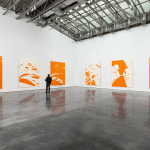In the Jewish Herald-Voice, Aaron Howard declares that history is harsh to painters. “In certain periods of art history, a few celebrity painters get the recognition, either because their art is appealing or their lives are intriguing. Consider the abstract expressionists, for example. The names Jackson Pollock and Mark Rothko come to mind. In contrast, the name of Ary Stillman is recognized only by art scholars and a few Houstonians. Stillman left New York City in 1955, and settled in Cuernavaca, Mexico, and later in Houston. Once Stillman was away from New York, his name fell into obscurity as pop art emerged in the 1960s. And yet, Stillman�s latter works, particularly the ones incorporating Mexican mythology, are amazingly strong paintings. And, when Stillman�s paintings are viewed as a body of work, they seem to encapsulate the history of contemporary art in the first half of the 20th century.” Read more.
Barry Lack, executive of the Stillman-Lack Foundation, is dedicated to making sure Stillman’s legacy survives. “Ary was well written about and had a lot of one-man and group shows in the 1920s through the �40s,� Lack said. “But in the 1950s, he lost his lease on his New York studio, and his health was failing. So, he left the New York scene. Critics have said this was a tactical mistake. In terms of strategic marketing � and you�d never hear this in the art world � an artist must continually brand himself. [You do that] by talking to art critics, getting written about and being researched � by creating a buzz about yourself.’�
Lack has organized a Stillman show this month at the Deutser Art Gallery in Houston. A big full-color catalogue, with an essay by Donald Kuspit accompanies the show. “�There are two elements to abstract expressionism,� Kuspit writes. �One is the idea of unconscious expression, especially Jung�s archetypes or what he called the �collective unconscious.� This expresses itself in some code. Stillman found this code in some sense in the Mayan hieroglyphs, which he understood as an early language. There is a surrealist basis for this, what Breton called an observed and internal reality. It�s a surreal language with traces of familiar language. Breton and other surrealists went back to pictographs and Egyptian hieroglyphs, getting away from representation.
�The shapes, form and colors are in interplay. With Stillman, it�s part of a larger context of the interest in primitivism. It�s amazing how many artists and theorists were interested in primitivism. The Jewish side comes in with a connection to Kabbalah. The lettering of the Hebrew language is archaic. That�s the jump that [Stillman] makes from the Jewish side to his abstract side. He knew all this stuff and it filters in, but not explicitly. To my mind, looking carefully at his works, he has this sort of Hebrew-Mayan-pictographic idea that converges into a picture writing that turns into gestures. In Stillman�s case, there�s the Mayan gestural script informed by a Kabbalistic consciousness of the Hebrew alphabet. There�s a kind of Jewish mysticism behind these interesting visual shapes.�
�Ary Stillman: From Impressionism to Abstract Expressionism,” curated by James Wechsler. Deutser Art Gallery, Houston, TX. Sept. 6-Oct. 24.






















